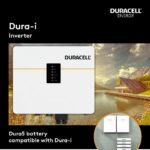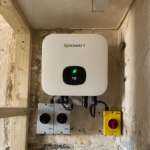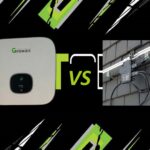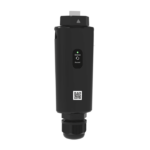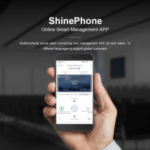Imagine waking up to a sunny morning, not just because the birds are chirping, but because your roof is silently turning sunlight into clean energy for your entire home. That’s the beauty of solar power, but with all the different equipment options, it can feel overwhelming. One crucial decision you’ll face is choosing between string inverters and microinverters. They both convert the sun’s direct current (DC) electricity into usable alternating current (AC) for your home appliances, but how they do it can significantly impact your solar panels system’s performance and longevity.
Let’s unpack the key differences between these two inverter technologies (string inverter vs microinverter), going beyond the typical price point comparisons to explore some lesser-discussed aspects that might be crucial for UK homeowners looking at investing in a solar panel system.
The String Inverter vs Microinverter Showdown
To put it in simple terms, think of a string inverter as the orchestra conductor. The string inverter sits in one central location and manages the power output from all your solar panels, which are connected in “strings” like instruments in an orchestra. If one solar panel underperforms due to shade or malfunction, the entire string’s output suffers – a phenomenon known as clipping. This can be a significant drawback, especially in the UK where unpredictable weather conditions can lead to partial shading of solar panels throughout the day.
Microinverters, on the other hand, are like soloists in an orchestra. Each panel gets its own dedicated microinverter attached directly to the back of each solar panel, converting DC to AC right at the source – the solar panel. This modular design ensures maximum power production from each solar panel, regardless of any shading or performance issues with other solar panels. It’s like each musician being able to shine, even if another hits a bum note.
Beyond Clipping: Unveiling Hidden Advantages of Microinverters
Here’s where things get interesting. Microinverters offer some unique benefits that might be particularly attractive for UK homeowners:
- Enhanced Safety: String inverters, due to their centralized design, can pose a higher risk of DC arcing – a potentially dangerous electrical fault. Microinverters minimize this risk by converting DC to AC at the solar panel level, keeping the high-voltage DC current off your roof.
- Future-Proofing: With the growing trend of battery storage for solar panel systems, microinverters offer a smoother integration. Since each solar panel has its own microinverter, it can easily connect to a battery energy storage system (BESS) for maximized self-consumption of your solar energy.
- Detailed Monitoring: Microinverters provide solar panel-level monitoring, allowing you to track the performance of each individual solar panel. This granular data is invaluable for identifying potential problems early on, ensuring optimal system performance over time.
Choosing the Right Fit for Your UK Solar Journey
String inverters remain a popular choice due to their lower upfront cost. However, for UK homeowners looking for a future-proof solar panel system with maximum performance, safety, and monitoring capabilities, microinverters offer a compelling alternative.
If you’re still unsure about which inverter technology is right for your solar ambitions, NXTGEN Energy can help. We’re a team of passionate solar energy experts here in the UK, dedicated to guiding UK homeowners towards the best solar solutions for their unique needs. Let’s chat and design a solar panel system that will keep your roof singing its clean energy song, rain or shine. So, are you ready to embrace the sunshine and explore the power of solar for your UK home?
String Inverter vs Microinverter FAQs for UK Homeowners
String inverters handle the entire solar panel system array at once, while microinverters convert power for each solar panel individually. Imagine a conductor (string inverter) vs. solo musicians (microinverter) for your solar orchestra.
In the UK’s unpredictable weather, shade can easily impact solar panels. With a string inverter, if one solar panel drops due to shade, the whole string’s output suffers. Microinverters ensure each solar panel keeps producing, maximizing your solar harvest.
Yes! String inverters use high-voltage DC current across your roof, which carries a risk of DC arcing (electrical faults). Microinverters convert to AC at each solar panel, keeping the safer AC current on your roof.
Absolutely! Since each solar panel has its own inverter in a microinverter system, it seamlessly integrates with battery energy storage systems (BESS) for maximized self-consumption of your solar energy.
Microinverters typically have a higher upfront cost compared to string inverters. However, the long-term benefits in performance, safety, and monitoring might outweigh the initial investment.
NXTGEN Energy’s solar energy experts understand the UK market and can guide you towards the best inverter solution for your specific needs and budget. We’ll design a solar panel system that optimizes your solar power journey!
Latest Inverter Posts
- Duracell Dura-i Inverter: Power Your Home with Efficiency and FlexibilityThe Duracell Energy Dura-i Inverter stands at the forefront of renewable energy technology, offering a robust solution for harnessing solar power efficiently. In this blog post, we will delve into the key features, benefits, and performance metrics of this innovative inverter. From its installation process to maintenance guidelines, we aim to provide a comprehensive guide… Read more: Duracell Dura-i Inverter: Power Your Home with Efficiency and Flexibility
- Solar Inverter Placement in Your HomeSolar Inverters Solar inverters are crucial for converting the direct current (DC) electricity generated by your solar panels into alternating current (AC) electricity for use in your home. The placement of your solar inverter can impact the efficiency and overall performance of your solar energy system. Things to consider when choosing where to place your… Read more: Solar Inverter Placement in Your Home
- String Inverter vs Microinverter: Centralized vs ModularImagine waking up to a sunny morning, not just because the birds are chirping, but because your roof is silently turning sunlight into clean energy for your entire home. That’s the beauty of solar power, but with all the different equipment options, it can feel overwhelming. One crucial decision you’ll face is choosing between string… Read more: String Inverter vs Microinverter: Centralized vs Modular
- How to Monitor Your Growatt Inverter with the Shine LAN-X DongleIf you have a Growatt inverter and you want to monitor its performance and status online, you might be interested in the Shine LAN-X dongle. This is a device that connects your inverter to your router via an Ethernet cable, allowing you to access the Shine Server platform and view your data on your computer… Read more: How to Monitor Your Growatt Inverter with the Shine LAN-X Dongle
- How to Monitor Your Growatt Inverter with the ShinePhone AppIf you have a Growatt inverter and you want to monitor its performance and status on your smartphone, you might be interested in the ShinePhone app. This is a mobile application that connects to the Growatt monitoring platform and allows you to access your inverter data anytime, anywhere. In this blog post, we will explain… Read more: How to Monitor Your Growatt Inverter with the ShinePhone App
- Do solar panels work in a power cut?☀️ Solar panels can work in a power cut, but only if they’re installed with a battery and a relay. ☀️ Power cuts cause solar panels to automatically switch off to protect electrical utility workers. ☀️ About 23% of the homes in the UK are affected by power cuts each year, and it’s going up.… Read more: Do solar panels work in a power cut?
- Solar Inverters, what are they and how do they work?What is a Solar Inverter and how does it work? One of the key components in any solar panel system is the solar inverter. The solar inverter converts the direct current (DC) electricity that the solar panels produce into alternating current (AC) electricity that your home appliances and the National Grid use. AC electricity has… Read more: Solar Inverters, what are they and how do they work?


